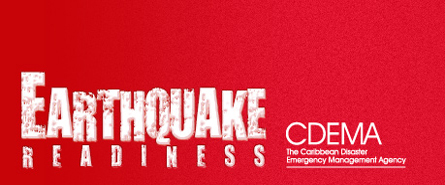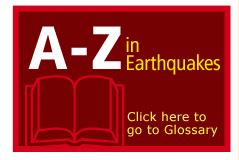
Earthquake Glossary
There are 16 entries in this glossary.| Term | Definition |
|---|---|
| Aftershock |
An earthquake of lower magnitude that follows the main earthquake, minutes to hours or even months after the main quake. |
| Disaster |
"...a process involving the combination of a potentially destructive agent(s) from the natural, modified and/or constructed environment and a population in a socially and economically produced condition of vulnerability, resulting in a perceived disruption of the customary relative satisfactions of individual and social needs for physical survival, social order and meaning" (Oliver-Smith 1998, 186) |
| Earthquake |
A sudden slipping or movement of a portion of the Earth's crust, accompanied and followed by a series of vibrations. |
| Earthquake Proof |
A building that is earthquake proof is expected to retain enough structural integrity to be safely re-used after the event. High value or essential facilities (fire and police stations, EOCs, or health facilities, which are all critical in the aftermath of a devastating earthquake, and schools) may have to be built to a higher standard than required by the code to remain operational after an event. |
| Earthquake Resistant |
A building that is earthquake resistant is expected to retain sufficient structural integrity during an earthquake to protect the people using the facility and permit them to evacuate safely after the event. New structures, if built to code are (by definition) earthquake resistant but not earthquake proof. |
| Epicenter |
The place on the earth's surface directly above the point on the fault where the earthquake rupture began. Once fault slippage begins, it expands along the fault during the earthquake and can extend hundreds of metres before stopping. |
| Fault |
The fracture along which displacement has occurred during an earthquake. The section that slips may range from less than two centimetres to more than 10 metres in a major earthquake. |
| Hazard |
A potentially damaging physical event, phenomenon or human activity that may cause the loss of life or injury, property damage, social and economic disruption or environmental degradation. Hazards can include latent conditions that may represent future threats and can have different origins: natural (geological, hydrometeorological and biological) or induced by human processes (environmental degradation and technological hazards). Hazards can be single, sequential or combined in their origin and effects. Each hazard is characterised by its location, intensity, frequency and probability. |
| Intensity |
A measure of an earthquake's effects at specific locations. The most commonly-used scale of intensity is the Modified Mercalli Intensity (MMI) index, which defines a range from one to twelve (I to XII), with one being the lowest and XII the highest intensity. |
| Liquefaction |
The process whereby earthquake shaking causes poorly consolidated ground with high water content to behave like a liquid. As a result, the ground can no longer support buildings. This is common on reclaimed land. |
| Magnitude |
Related to the amount of energy released during an earthquake. It is determined from parameters of the seismic waves recorded on seismographs e.g. amplitude, period, duration. A magnitude of 7.0 on the Richter Scale is a major earthquake. Each whole number on the scale represents an increase of about 10 times more energy released than the previous whole number represents. Therefore, an earthquake measuring 7.0 is about 100 times more powerful than one measuring 5.0. |
| Seiches |
The sloshing of a closed body of water such as a lake or swimming pool from earthquake shaking. |
| Seismic Waves |
Vibrations that travel outward from the earthquake fault at speeds of several kilometres per second. While fault slippage directly under a structure can cause considerable damage, the vibrations produced by seismic waves cause most of the destruction during earthquakes. |
| Tele-tsunami |
Tsunami caused by a distant, extra-regional earthquake. |
| Tsunami Warning Signs |
A strong earthquake lasting 20 seconds or more, a noticeably rapid rise or fall in coastal waters, a significant withdrawal of the sea and/or a roaring sound are all possible warning signs of an approaching tsunami. |



Home | Glossary | Contact Us | Sitemap | Disclaimer









